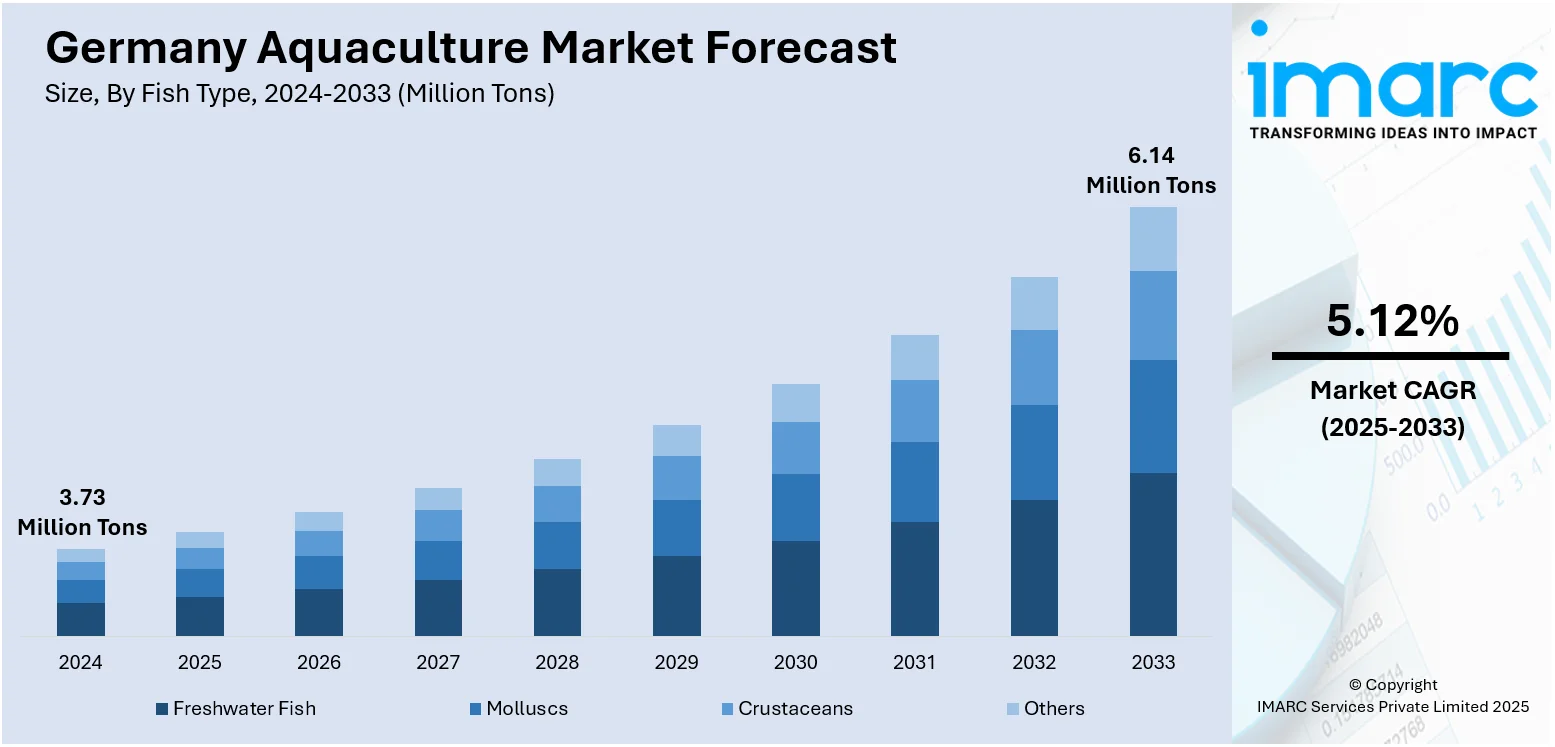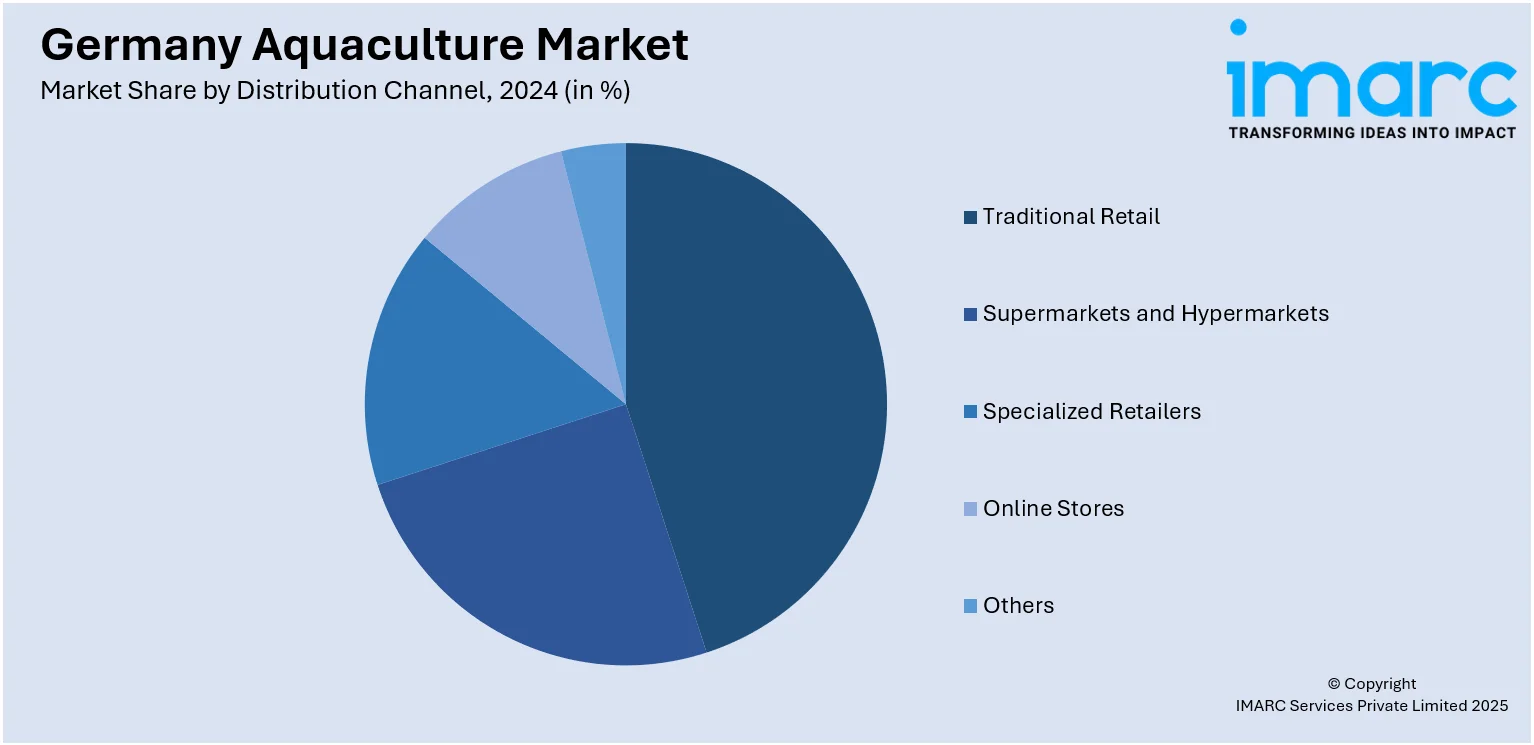
Germany Aquaculture Market Size, Share, Trends and Forecast by Fish Type, Environment, Distribution Channel, and Region, 2025-2033
Germany Aquaculture Market Overview:
The Germany aquaculture market size reached 3.73 Million Tons in 2024. Looking forward, the market is projected to reach 6.14 Million Tons by 2033, exhibiting a growth rate (CAGR) of 5.12% during 2025-2033. The market is growing, supported by consumer demand for sustainably produced seafood, robust environmental policies, and R&D innovations in feed and species genetics. RAS and closed systems enhance viability, further moving the Germany aquaculture market share toward an upward trajectory.
|
Report Attribute
|
Key Statistics
|
|---|---|
|
Base Year
|
2024
|
|
Forecast Years
|
2025-2033
|
|
Historical Years
|
2019-2024
|
| Market Size in 2024 | 3.73 Million Tons |
| Market Forecast in 2033 | 6.14 Million Tons |
| Market Growth Rate 2025-2033 | 5.12% |
Germany Aquaculture Market Trends:
Sustainable Feed and Alternative Proteins
German aquaculture is pivoting toward eco-friendly feed solutions, including insect meal, algae-derived biomass, and sustainable plant proteins. These ingredients lower pressure on marine ecosystems and enhance nutritional value. Tackling feed limitations also aligns with national sustainability policy. Simultaneously, precision nutrition—tailored feeds responsive to species lifecycle phases—is improving efficiency and reducing waste. Institutions and private firms are collaborating on feed trials and impact assessments. These efforts are central to Germany aquaculture market growth, merging environmental care with resource-effective production strategies. For instance, in November 2024, German companies WEDA Dammann & Westerkamp and Damm Aquakultur partnered to advance shrimp and fish farming in Germany. The collaboration focuses on sustainable, medication-free aquaculture using innovative technologies in feeding, water treatment, and rearing. Damm operates a high-tech shrimp facility, while WEDA contributes proven feeding systems that reduce waste and enhance efficiency.

To get more information on this market, Request Sample
Accelerated Recirculating Aquaculture Systems (RAS) Integration
Germany’s adoption of RAS systems is accelerating, leveraging their closed-loop water management, disease control, and consistent production results. Advantageous for urban-adjacent operations, RAS reduces land and water footprint while supporting high-density farming. Innovations include smart filtration, oxygenation, and monitoring systems. Investors are encouraged by reduced environmental risk and increased biosecurity. These systems are pivotal drivers of Germany aquaculture market growth, as they foster reliable, sustainable aquaculture expansion. As of 2024, the German start-up Seawater Cubes is pursuing €3 Million in funding to expand its plug-and-play recirculating aquaculture system (RAS), aimed at decentralizing small-scale fish farming. Housed in repurposed shipping containers, the modular system can produce up to 8 metric tons of fish per year, making it well-suited for urban and land-based settings. Supported by €1.5 Million in government funding, the company has successfully piloted sea bass and sea bream. The user-friendly system is geared toward farmers, cooperatives, and urban food initiatives focused on sustainable aquaculture.
Germany Aquaculture Market Segmentation:
IMARC Group provides an analysis of the key trends in each segment of the market, along with forecasts at the region/country level for 2025-2033. Our report has categorized the market based on fish type, environment, and distribution channel.
Fish Type Insights:
- Freshwater Fish
- Molluscs
- Crustaceans
- Others
The report has provided a detailed breakup and analysis of the market based on the fish type. This includes freshwater fish, molluscs, crustaceans, and others.
Environment Insights:
- Fresh Water
- Marine Water
- Brackish Water
A detailed breakup and analysis of the market based on the environment have also been provided in the report. This includes fresh water, marine water, and brackish water.
Distribution Channel Insights:

- Traditional Retail
- Supermarkets and Hypermarkets
- Specialized Retailers
- Online Stores
- Others
The report has provided a detailed breakup and analysis of the market based on the distribution channel. This includes traditional retail, supermarkets and hypermarkets, specialized retailers, online stores, and others.
Regional Insights:
- Western Germany
- Southern Germany
- Eastern Germany
- Northern Germany
The report has also provided a comprehensive analysis of all the major regional markets, which include Western Germany, Southern Germany, Eastern Germany, and Northern Germany.
Competitive Landscape:
The market research report has also provided a comprehensive analysis of the competitive landscape. Competitive analysis such as market structure, key player positioning, top winning strategies, competitive dashboard, and company evaluation quadrant has been covered in the report. Also, detailed profiles of all major companies have been provided.
Germany Aquaculture Market News:
- In February 2025, Castell Salmon announced initiative to launch one of Germany’s first commercial land-based salmon farms in Griestal. Using recirculating aquaculture system (RAS) technology, the facility will produce 1,200 metric tons of Atlantic salmon annually, with the first harvest expected by mid-2029. Built on a former trout and char site near the Bavarian Alps, the project benefits from excellent water resources, logistics, and regional market access.
- In November 2024, the European Investment Bank (EIB) provided €35 Million in venture debt to Oceanloop, a German aquaculture tech company, to scale its sustainable indoor shrimp farming using recirculating aquaculture systems (RAS). The investment, backed by the EU’s InvestEU program, will expand a pilot farm in Kiel and fund a 2,000-tonne facility in Gran Canaria. Oceanloop’s modular, AI-integrated system offers a sustainable alternative to shrimp imports, aiming to reduce environmental impact and increase Europe’s food security with locally produced, high-quality protein.
Germany Aquaculture Market Report Coverage:
| Report Features | Details |
|---|---|
| Base Year of the Analysis | 2024 |
| Historical Period | 2019-2024 |
| Forecast Period | 2025-2033 |
| Units | Million Tons |
| Scope of the Report |
Exploration of Historical Trends and Market Outlook, Industry Catalysts and Challenges, Segment-Wise Historical and Future Market Assessment:
|
| Fish Types Covered | Freshwater Fish, Molluscs, Crustaceans, Others |
| Environments Covered | Fresh Water, Marine Water, Brackish Water |
| Distribution Channels Covered | Traditional Retail, Supermarkets and Hypermarkets, Specialized Retailers, Online Stores, Others |
| Regions Covered | Western Germany, Southern Germany, Eastern Germany, Northern Germany |
| Customization Scope | 10% Free Customization |
| Post-Sale Analyst Support | 10-12 Weeks |
| Delivery Format | PDF and Excel through Email (We can also provide the editable version of the report in PPT/Word format on special request) |
Key Questions Answered in This Report:
- How has the Germany aquaculture market performed so far and how will it perform in the coming years?
- What is the breakup of the Germany aquaculture market on the basis of fish type?
- What is the breakup of the Germany aquaculture market on the basis of environment?
- What is the breakup of the Germany aquaculture market on the basis of distribution channel?
- What is the breakup of the Germany aquaculture market on the basis of region?
- What are the various stages in the value chain of the Germany aquaculture market?
- What are the key driving factors and challenges in the Germany aquaculture market?
- What is the structure of the Germany aquaculture market and who are the key players?
- What is the degree of competition in the Germany aquaculture market?
Key Benefits for Stakeholders:
- IMARC’s industry report offers a comprehensive quantitative analysis of various market segments, historical and current market trends, market forecasts, and dynamics of the Germany aquaculture market from 2019-2033.
- The research report provides the latest information on the market drivers, challenges, and opportunities in the Germany aquaculture market.
- Porter's five forces analysis assist stakeholders in assessing the impact of new entrants, competitive rivalry, supplier power, buyer power, and the threat of substitution. It helps stakeholders to analyze the level of competition within the Germany aquaculture industry and its attractiveness.
- Competitive landscape allows stakeholders to understand their competitive environment and provides an insight into the current positions of key players in the market.
Need more help?
- Speak to our experienced analysts for insights on the current market scenarios.
- Include additional segments and countries to customize the report as per your requirement.
- Gain an unparalleled competitive advantage in your domain by understanding how to utilize the report and positively impacting your operations and revenue.
- For further assistance, please connect with our analysts.
 Request Customization
Request Customization
 Speak to an Analyst
Speak to an Analyst
 Request Brochure
Request Brochure
 Inquire Before Buying
Inquire Before Buying




.webp)




.webp)












